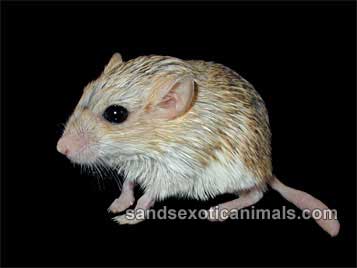
Origin:
The fat-tailed duprasi comes from the arid regions of Africa, north of the Sahara desert.Description:
Duprasi have golden blond fur with a white underbelly and a flat, lightly furred tail. The body of an adult is approximately 3 to 4 inches in length with a tail of about 2 inches. The tail enables the duprasi to store water and fat. The duprasi is diurnal meaning it is active both day and night.Feeding:
A good diet consists of a combination of grains, seeds, nuts, fruits, insects, eggs and small vertebrates. You should give them hamster mix plus a small amount of raw peanuts and sunflower seeds every day. At night you can offer them in a separate bowl a little bit of sliced fruits and vegetables. The fruits and vegetables can be fresh, frozen or canned. You can alternate the fruit with a mix of chopped boiled egg, crickets or mealworms. Purchase the crickets or mealworms from a pet store. Do not collect insects from outside since they could be contaminated with pesticides. Rodent block can also be used for a source of protein. Try to offer a variety of these items since all duprasi don't have the same preferences. Monkey biscuits can also be given as a treat once or twice a week. Provide fresh water in a water bottle daily. You can also add vitamin drops to their water.Housing:
Duprasi should be housed in a 10 gallon (or larger) aquarium. A heavy screen top is the best cover. Wood shavings or aspen bedding provide a suitable bedding material and all types of wood except cedar are acceptable. The bedding should be at least 1 inch thick. Duprasi can exercise inside the aquarium and love to play. An exercise wheel should be added to their habitat. Duprasi like to crawl through pieces of PVC pipe. They will often bury the pipe and use it for tunnels. Cat litter that is non-clumping may also be used to simulate their natural habitat.Hygiene:
Duprasi are very clean animals. They spend lots of time grooming their fur and washing their faces. Twice a week place a small container of sand in each cage. This keeps their coats clean and fluffy.Longevity:
Up to 5 years in captivity
Compliments of:
S & S Exotic Animals, Inc., 1711 Connorvale, Houston, TX 77039 (281) 590-0426
http://www.sandsexoticanimals.com
